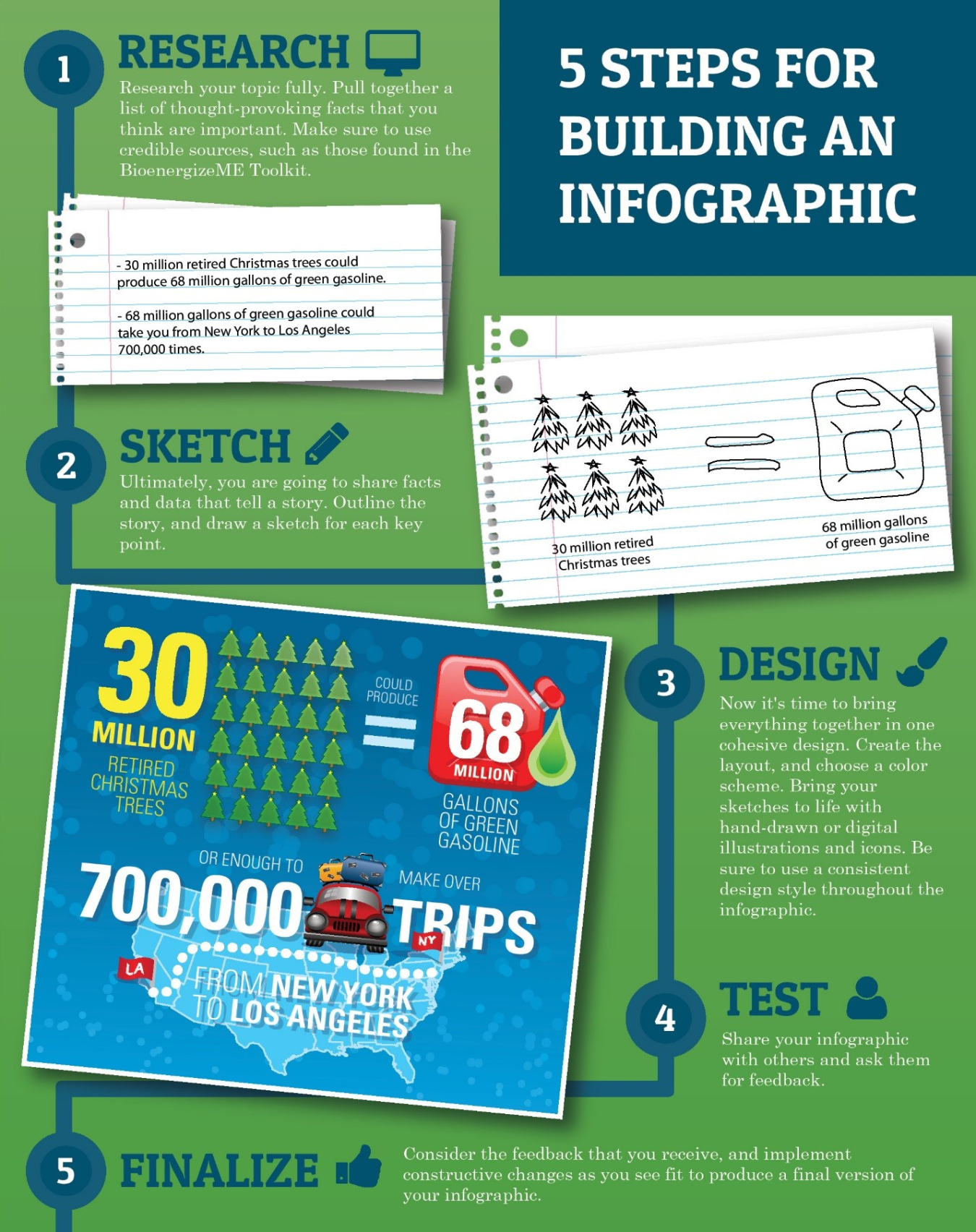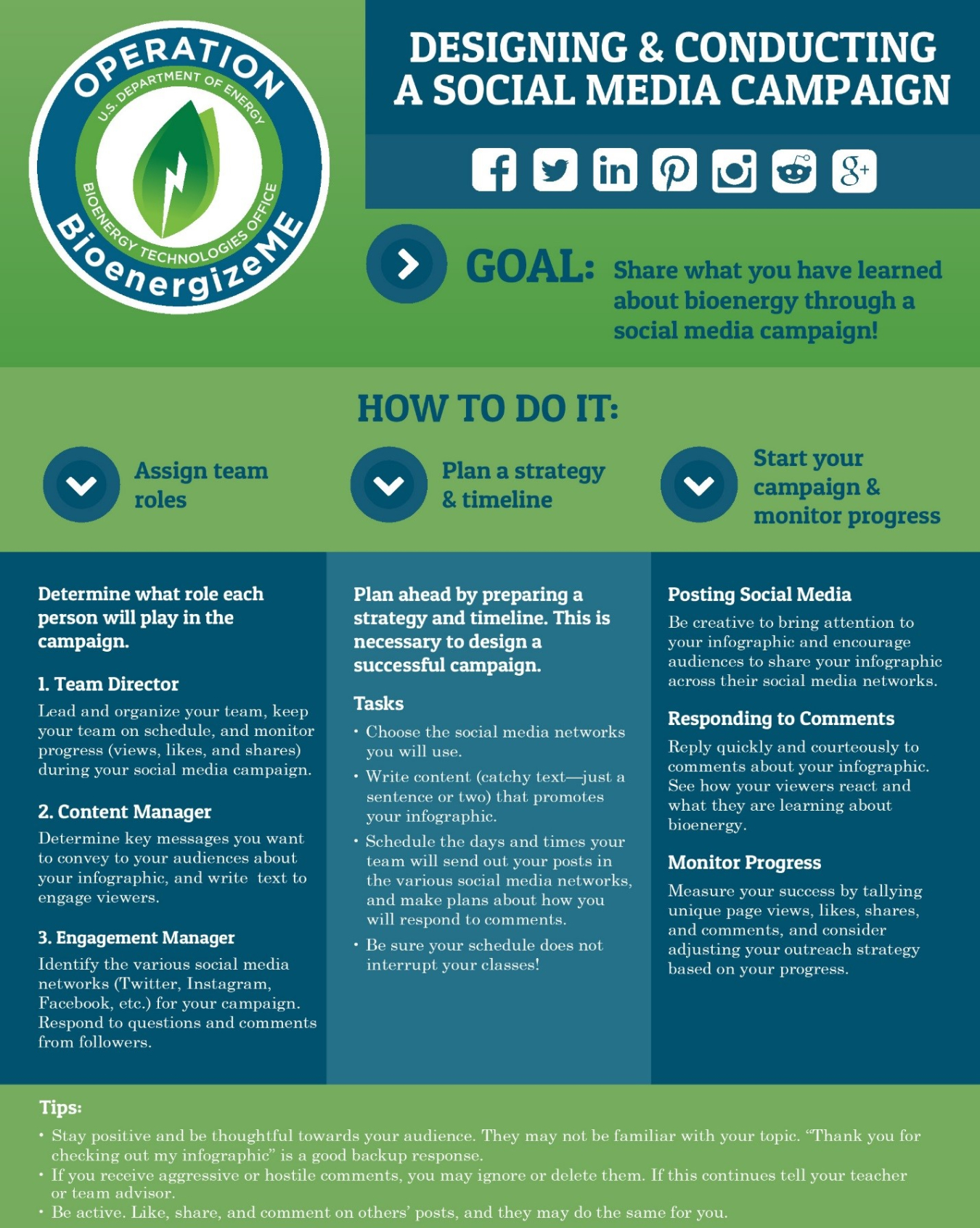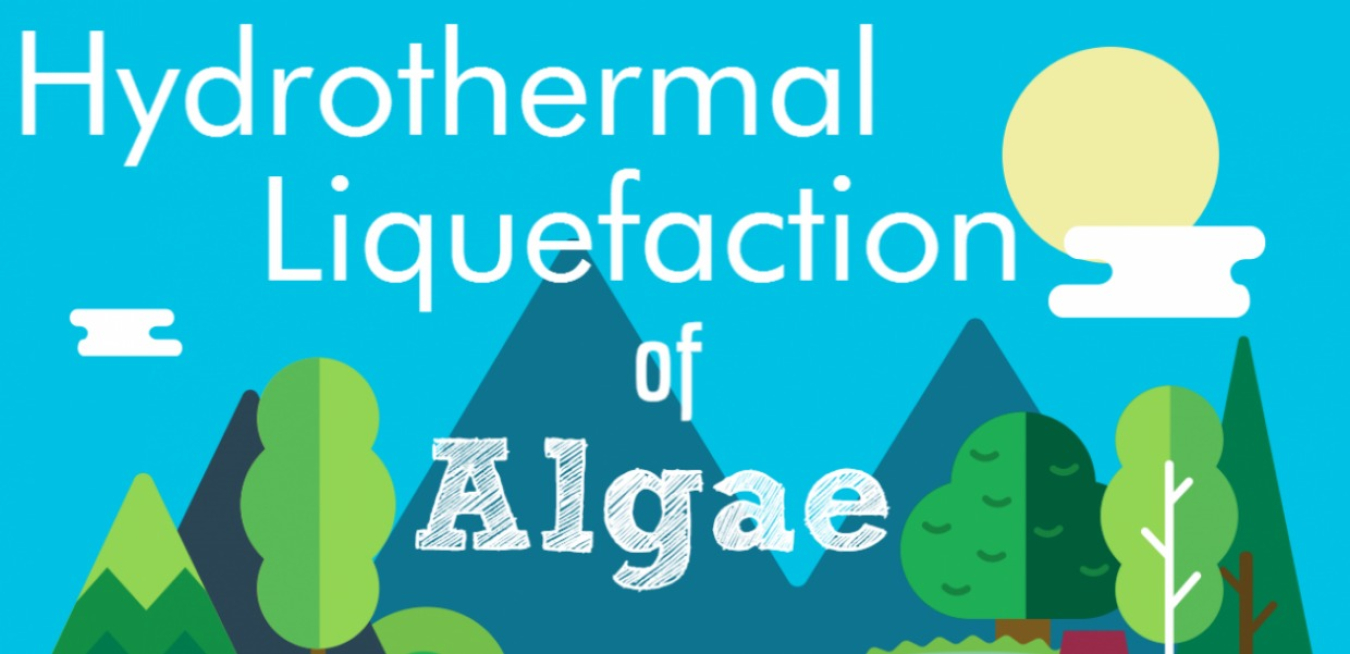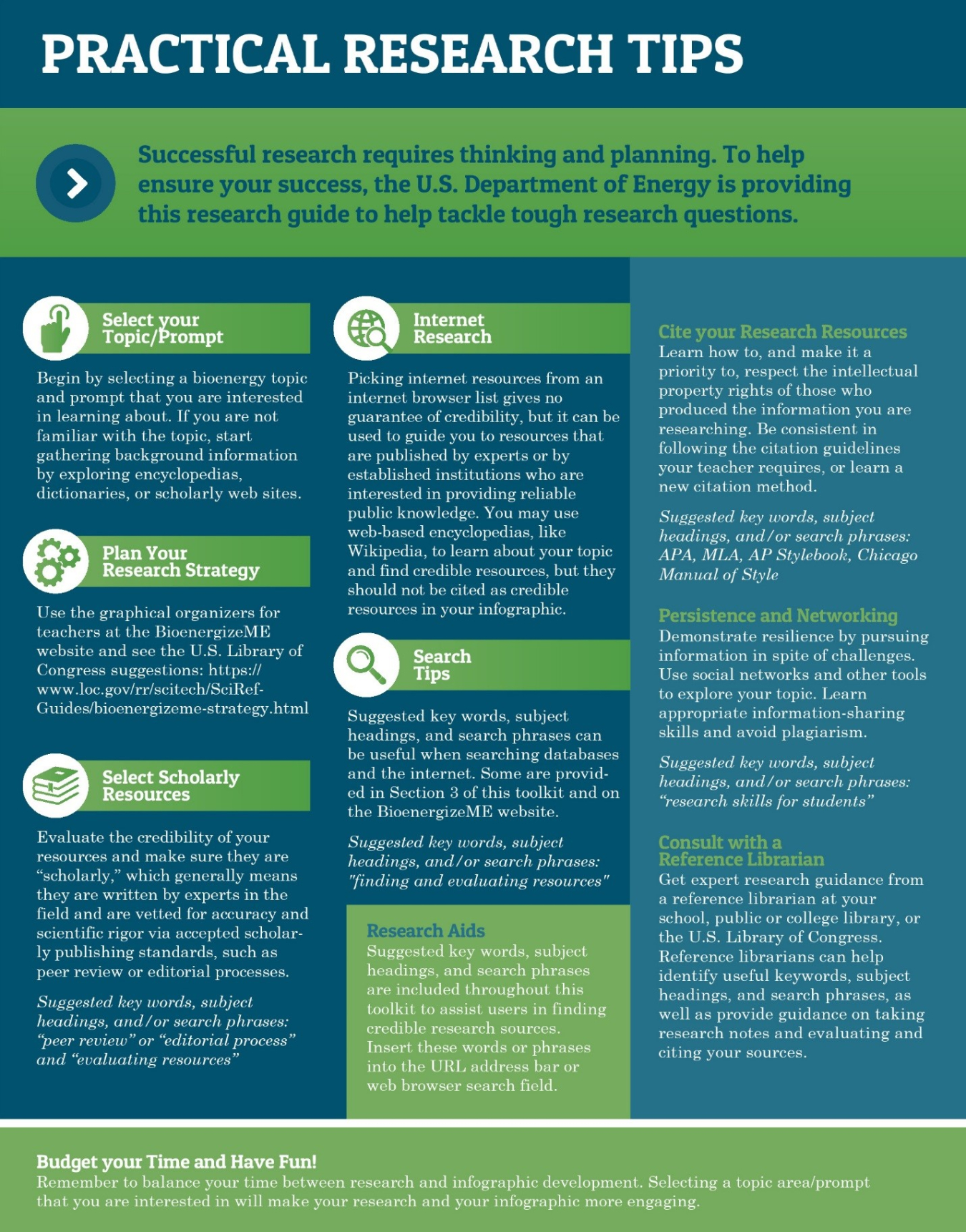The U.S. Department of Energy’s (DOE) BioenergizeME Infographic Challenge is an engaging and fun way for students to use technology to learn about bioenergy in the classroom. In this activity, anyone can now explore one or more bioenergy research prompts and then communicate what they’ve learned in an infographic. BioenergizeME Infographic Challenge instructions, topic areas/prompts, print-ready tools, and activity ideas are provided.
This Challenge incorporates research, interpretation, synthesis, design, and collaboration skills, while participants use their creativity to illustrate their research findings.
Today’s students are the nation’s future leaders, and one of their energy options will be bioenergy. The BioenergizeME Infographic Challenge helps them understand how bioenergy plays a part in the U.S. energy portfolio.
Check out these resources for learning about bioenergy and the BioenergizeME Infographic Challenge:
PRINT-READY RESOURCES
The BioenergizeME Infographic Challenge is suitable for both classroom and independent educational use and is designed to provide an opportunity for educators to incorporate arts-based learning of STEM into their classrooms.
In the classroom environment, students learn to present BioenergizeME projects in the form of infographics, which is an interesting and quick way to communicate ideas and educate others. A strong BioenergizeME infographic should convey a well-focused message that is predominantly image-led and that a general audience can understand in just a few minutes.
The Next-Generation Science Standards (NGSS) Rationale provides practical, teacher-based suggestions for how the BioenergizeME Infographic Challenge can fulfill NGSS. Those who want to learn more about NGSS can view this link: https://www.nextgenscience.org/
Subject/Course: Science
Topic/Theme/Nature of Investigation: Sources of Energy
Grade Level: 9–12
Duration: 30–45 min
NGSS Science and Engineering Practices:
- Planning and Carrying Out Investigations
- Constructing Explanations and Designing Solutions
NGSS Disciplinary Core Ideas:
- PS3.A: Definitions of Energy
- PS3.B: Conservation of Energy and Energy Transfer
- ETS1.A: Defining and Delimiting an Engineering Problem
NGSS Crosscutting Concepts:
- Systems and System Models
- Energy and Matter
WHY BIOENERGY? WHY NOW?
Bioenergy has come a long way since wood, dung, and other organic matter was first burned for light and heat by early human civilization. There are many ways to capture bioenergy from organic materials, and technologies are advancing to use bioenergy more efficiently.
In the United States, biomass is one of many varied resources used to meet America’s energy needs. As our awareness increases about the uncertain availability of energy resources, other socially important effects of producing and using them, as well as U.S. opportunities for bioenergy careers and other economic development growth, it is more important than ever to understand:
- Basic next-generation bioenergy concepts
- Next-generation biomass resources and bioenergy technologies, as well as their benefits
- How students and their peers can play an important role in shaping America’s energy future.
UNDERSTANDING NEXT-GENERATION BIOENERGY CONCEPTS
Keep the following considerations in mind when researching and developing infographics:
- Bioenergy is one of several energy resource options for the United States
- Biomass is a versatile resource in the United States and can be used to produce bioenergy and supplement fossil fuels
- Next-generation bioenergy can provide a renewable alternative for the many industrial products and materials made from petroleum or natural gas, such as plastics, fertilizers, lubricants, and industrial chemicals
- Next-generation bioenergy needs to be produced in a manner that protects natural resources and provides U.S. opportunities.
WHAT NEXT-GENERATION BIOENERGY IS, AND ISN’T
Bioenergy is produced from organic materials that contain stored energy from the sun. Products that do not compete with food and feed demands are used as feedstocks to produce next-generation bioenergy. Next-generation bioenergy feedstocks can be produced from a variety of organic resources, including
- non-grain agricultural residues such as corn stover (stalks, leaves, and cobs) and grain straws,
- processing wastes such as sugar cane bagasse or distillers dried grains,
- energy crops, such as switchgrass, miscanthus, or energy cane,
- forest residues,
- woody plantation crops,
- algae, and
- municipal solid waste.
Bioenergy can be in the form of
- renewable transportation biofuels,
- chemicals, foods, plastics, and fabrics, that can be produced from biomass, and
- products that evolve from the biofuel industry, such as lignin, electricity, and processing heat.
Next-generation bioenergy DOES NOT include
- solar, wind, water, geothermal, or nuclear energy,
- fossil energy sources, like coal, oil, or natural gas, and
- agricultural grains, such as corn kernels and wheat.
This was an empty link: RESEARCH TOPIC AREAS/PROMPTSRESEARCH TOPIC AREAS/PROMPTS
The research topic areas help students explore the role of bioenergy in the context of an energy landscape that has changed many times throughout human history. Within each topic area are prompts that are foundational, broad, and open-ended to foster student-centered discovery. Suggested key words, subject headings, and search phrases are included to assist students in finding credible research sources. Insert these words or phrases into the URL address bar or web browser search field (to limit researched sources to the most relevant, researchers can include a key word, subject heading, and/or search phrase with “biomass, “bioenergy,” “biobased,” or other phrases included in the topic areas and prompts.) For additional research guidance, see Appendix A - Practical Research Tips.
Topic Area 1 - History of Modern Bioenergy
Discuss the progression of first-generation bioenergy feedstocks to next-generation or advanced bioenergy feedstocks.
What is bioenergy? What is biomass?
What is a feedstock? What is a first-generation feedstock? What is a next-generation or advanced feedstock?
Why have researchers expanded our biomass resources to include next-generation feedstocks?
Name some benefits and research challenges associated with next-generation feedstocks?
Suggested key words, subject headings, and/or search phrases: bioenergy, biomass, feedstock, next-generation feedstocks
Topic Area 2 – Science and Technology
There are a variety of technology pathways used to convert algae, diverse cellulosic resources, and other emerging feedstocks into final bioenergy products. Please choose one pathway from the list below and describe/illustrate the progression from feedstock to finished product.
1. Algae and Biochemical Processing
Algae Biomass → Harvesting → Dewatering → Extraction → Fractionation → Upgrading → Finished Fuel Product
2. Algae and Hydrothermal Liquefaction
Algae Biomass → Harvesting → Dewatering → Hydrothermal Liquefaction → Upgrading → Finished Fuel Product
3. Cellulosic Biomass to Ethanol
Cellulosic Biomass → Pretreatment → Hydrolysis → Fermentation → Distillation → Ethanol
4. Cellulosic Biomass to Renewable Hydrocarbon Fuels (Biochemical)
Cellulosic Biomass → Pretreatment → Deconstruction with Microorganism or Biological Molecule → Sugar → Chemical Upgrading → Hydrocarbon Fuel
5. Cellulosic Biomass to Renewable Hydrocarbon Fuels (Thermochemical)
Cellulosic Biomass → Pyrolysis/Gasification → Bio-oil/Synthesis Gas → Chemical Upgrading → Hydrocarbon Fuel
6. Biomass to Biobased Products
Biomass resource → conversion pathway (including illustration of the supply chain and any associated co-products) → end product → unique benefits and challenges.
Suggested key words, subject headings, and/or search phrases: algae biomass, renewable, crop residues, forest biomass, bio-oil, hydrothermal liquefaction, catalysis
Topic Area 3 - Workforce Development
Bioenergy relies on biological resources to produce biofuels, biobased co-products, and biopower. For the bioenergy industry to thrive, a diverse and skilled technical and non-technical workforce will be required. Discuss bioenergy-related workforce development resources and/or programs as well as the characteristics of the workforce needed to support this growing industry.
Describe one or more technical fields or disciplines that could lead to a career in bioenergy
Describe one or more non-technical fields or disciplines that could lead to a career in bioenergy
Research a bioenergy-related higher education program or workforce development institution in your state or region. How can the skills or knowledge gained from this program/institution apply to a career in the bioenergy industry?
Suggested key words, subject headings, and/or search phrases: bioenergy career map, communications specialist, natural resource manager, chemical engineer, chemical technician
Topic Area 4 – Next-Generation This was an empty link: BioenergyBioenergy
Bioenergy is being explored for the best ways to incorporate it into society, which may differ from location to location, depending on biomass resources available and industry demands.
Discuss the goals, technical and market-based opportunities and challenges, and feedstock-to-finished product supply chains for specific next-generation bioenergy applications that DOE is exploring.
This was an empty link: Alternative Aviation FuelsAlternative Aviation Fuels
Biofuels are needed in the aviation industry, where liquid fuels are currently the only viable fuel source. The commercial aviation industry and the military have goals to increase the domestic renewable jet fuel supply.
This was an empty link: Co-OptimaCo-Optima
DOE is working to explore synergies among the fuels, engines, and powertrains used in today’s traditional vehicles. This work, called Co-Optima, is also investigating opportunities related to hybrid and plug-in hybrid technologies, as well as advanced compression-ignition solutions.
This was an empty link: Waste to EnergyWaste to Energy
Wet waste, solid waste, and gaseous waste streams are potential high-impact resources for the domestic production of biogas, biofuels, bioproduct precursors, heat, and electricity. These streams are available now without land-use change, and in many cases, their use helps to address the unique and local challenges of disposing of them.
This was an empty link: Performance-Advantaged Biobased ProductsPerformance-Advantaged Biobased Products
The ideal biobased product could allow for new functionality in end products and generate new markets for manufacturers of biobased materials. These products could increase the value of domestic biomass resources and provide a new revenue stream for biorefineries.
Suggested key words, subject headings, and/or search phrases: Co-Optima, hybrid vehicle technologies, aviation biofuels, municipal solid waste, waste to energy, biorefineries, co-products, lignin, valorization
This Teacher Guide aligns with the U.S. Department of Energy (DOE) Bioenergy Technologies Office’s (BETO) BioenergizeME Infographic Challenge, an engaging and fun guide for helping students use technology to learn about bioenergy. The BioenergizeME Infographic Challenge provides a framework for participants to explore one or more bioenergy research prompts and then communicate what they’ve learned in an infographic. The Challenge incorporates research, interpretation, synthesis, design, and collaboration skills, while participants use their creativity to illustrate the findings of their research.
This Teacher Guide is comprised of aids for teachers who wish to include bioenergy and/or the BioenergizeME Infographic Challenge in their curriculums, and includes
- web links to valuable resources for incorporating bioenergy and exploration of bioenergy career opportunities in the classroom,
- web links to the latest in bioenergy research,
- a concept map to help students focus on fundamental bioenergy understanding,
- research guides aligned to BioenergizeME Infographic Challenge topic areas/prompts, and
- a rubric to guide infographic development and evaluation.
Valuable resources for incorporating bioenergy and exploration of bioenergy workforce development in the classroom:
- Workforce Development Resources
- Bioenergy Career Map
- Bioenergy Internship and Fellowship Opportunities
The latest in bioenergy research
- This was an empty link: Bioenergy BasicsBioenergy Basics
BioenergizeME Infographic Challenge - Teacher Guide
- BioenergizeME Infographic Challenge Concept Map and Bioenergy Introduction
- BioenergizeME Infographic Challenge Note Guides (with focus on next-generation bioenergy)
- BioenergizeME Infographic Challenge Rubric
INTRODUCTION TO This was an empty link: BIOENERGYBIOENERGY
See the BETO Bioenergy Basics website to learn about bioenergy, and this concept map to start exploring the topic. Students can write 2–3 main concepts or ideas in each bubble.
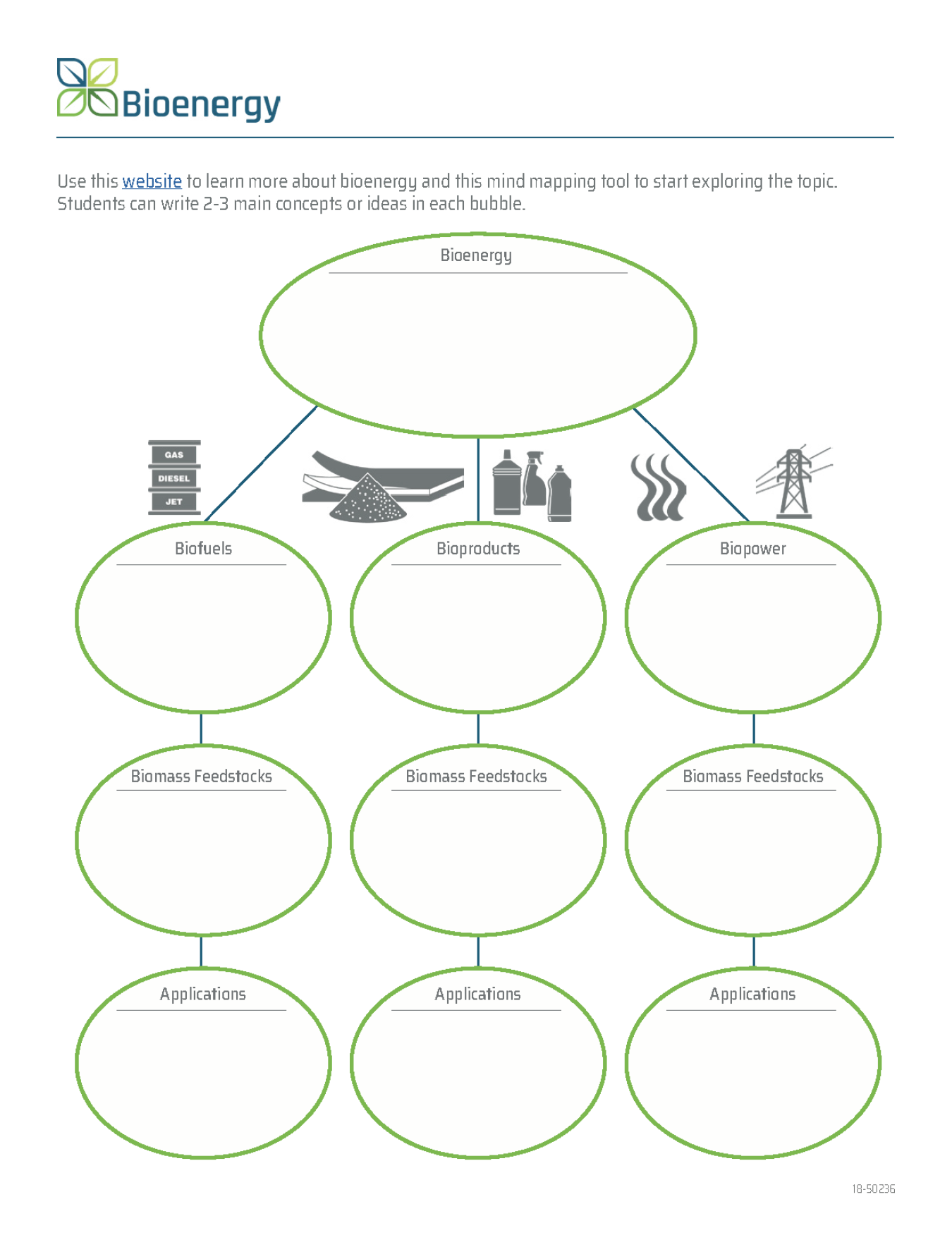
INTRODUCTION TO This was an empty link: BIOENERGYBIOENERGY
See the DOE Bioenergy Basics website to learn about biomass, biofuels, and bioproducts and answer the following questions:
1. Why do we need a diverse portfolio of energy resources in the United States?
2. What is biomass?
3. Describe cellulosic fuels.
4. Describe two types of biofuels.
5. Describe bioproducts and provide examples of bioproducts that DOE and BETO are researching.
This was an empty link: NOTE GUIDE: BIOENERGIZEME INFOGRAPHIC CHALLENGE RESEARCH TOPIC AREA/PROMPTSNOTE GUIDE: BIOENERGIZEME INFOGRAPHIC CHALLENGE RESEARCH TOPIC AREA/PROMPTS
This was an empty link: Topic Topic Area 1 - History of Modern Bioenergy
Suggested key words, subject headings, and/or search phrases: bioenergy, biomass, feedstock, next-generation feedstocks
Guiding Questions:
1. What is bioenergy? What is biomass?
Key Points:
Reference(s):
2. What is a feedstock? What is a first-generation feedstock? What is a next-generation or advanced feedstock?
Key Points:
Reference(s):
3. Why have researchers expanded our biomass resources to include next-generation feedstocks?
Key Points:
Reference(s):
4. Name some benefits and research challenges associated with next-generation feedstocks?
Key Points:
Reference(s):
This was an empty link: NOTE GUIDE: BIOENERGIZEME INFOGRAPHIC CHALLENGE RESEARCH TOPIC AREA/PROMPTSNOTE GUIDE: BIOENERGIZEME INFOGRAPHIC CHALLENGE RESEARCH TOPIC AREA/PROMPTS
This was an empty link: TopicTopic Area 2 - Bioenergy and Technology
Choose one pathway from the list below and describe/illustrate the progression from feedstock to finished product.
Suggested key words, subject headings, and/or search phrases: algae biomass, renewable, crop residues, forest biomass, bio-oil, hydrothermal liquefaction, catalysis
Guiding Questions:
1. What are algae and biochemical processing?
Key Points:
Reference(s):
2. Describe the process of algae and hydrothermal liquefaction and possible products.
Key Points:
Reference(s):
3. Describe how cellulosic biomass is converted to ethanol and some possible uses.
Key Points:
Reference(s):
4. Describe how cellulosic biomass is converted to renewable hydrocarbon fuels via a biochemical process.
Key Points:
Reference(s):
5. Describe how cellulosic biomass is converted to renewable hydrocarbon fuels via thermochemical process.
Key Points:
Reference(s):
6. Describe bioproducts and how biomass can be used to create bioproducts. What are some of the challenges of this process?
Key Points:
Reference(s):
This was an empty link: NOTE GUIDE: BIOENERGIZEME INFOGRAPHIC CHALLENGE RESEARCH TOPIC AREA/PROMPTSNOTE GUIDE: BIOENERGIZEME INFOGRAPHIC CHALLENGE RESEARCH TOPIC AREA/PROMPTS
This was an empty link: TopicTopic Area 3 - Workforce and Education
Suggested key words, subject headings, and/or search phrases: bioenergy career map, communications specialist, natural resource manager, chemical engineer, chemical technician
Guiding Questions:
1. Describe one or more technical fields or disciplines that could lead to a career in bioenergy.
Key Points:
Reference(s):
2. Describe one or more non-technical fields or disciplines that could lead to a career in bioenergy?
Key Points:
Reference(s):
3. Research a bioenergy-related higher education program or job training institution in your state or region. How can the skills or knowledge gained from this program/institution apply to a career in the bioenergy industry?
Key Points:
Reference(s):
This was an empty link: NOTE GUIDE: BIOENERGIZEME INFOGRAPHIC CHALLENGE RESEARCH TOPIC AREA/PROMPTSNOTE GUIDE: BIOENERGIZEME INFOGRAPHIC CHALLENGE RESEARCH TOPIC AREA/PROMPTS
This was an empty link: TopicTopic Area 4 – Next-Generation Bioenergy
Suggested key words, subject headings, and/or search phrases: Co-Optima, hybrid vehicle technologies, aviation biofuels, municipal solid waste, waste to energy, biorefineries, co-products, lignin, valorization
Guiding Questions:
1. Describe how biomass can be used to produce alternative aviation fuels.
Key Points:
Reference(s):
2. Describe the Co-Optima program and how DOE’s BETO and VTO are working together to explore synergies among the fuels, engines, and powertrains used in today’s traditional vehicles.
Key Points:
Reference(s):
3. Describe how wet waste, solid waste, and gaseous waste streams can be used as resources for the domestic production of biogas, biofuels, bioproduct precursors, heat, and electricity.
Key Points:
Reference(s):
4. Describe performance-advantaged biobased products and their potential to BETO and the bioenergy industry.
Key Points:
Reference(s):
BIOENERGIZEME INFOGRAPHIC CHALLENGE This was an empty link: RUBRICRUBRIC
A grading rubric is provided for students as they create their infographics and teachers as they grade the students’ work.
BIOENERGIZEME INFOGRAPHIC CHALLENGE COMPETITION
The BioenergizeME Infographic Challenge is designed for teams of two to six students (grades 9–12). Each infographic responds to one of the research topics and prompts provided in Section 3 - Next-Generation Bioenergy Concepts, and on the BioenergizeME Infographic Challenge website. Students should make sure their infographic communicates a well-focused thesis. The final team infographics are judged by a review committee. Examples of a competitive challenge structure, rules, reviewing and judging recommendations, and incentive ideas are included below.
This was an empty link: BioenergizeME Infographic Challenge Competition StructureBioenergizeME Infographic Challenge Competition Structure
- Student groups are separated into infographic teams
- Student teams research a bioenergy topic area/prompt
- Student teams decide on a focusing message or thesis
- Student teams create an infographic to communicate what they have learned about bioenergy
- Review team judges the infographics according to the infographic rubric.
Challenge Rules
- Infographics must exclude personal identifiable information (e.g., names, emails)
- Each infographic must respond to one topic area/ prompt found in the BioenergizeME Toolkit and on the BioenergizeME Infographic Challenge website
- Each infographic must be image-led, using illustrations and/or graphics to communicate the team’s research findings
- Infographics must cite sources for all facts, numbers, and images; sources should be referenced as footnotes at the bottom of the infographic
- Each submission must be the contestants’ original work and must not plagiarize, infringe, misappropriate, or otherwise violate any intellectual property rights, privacy rights, or any other rights of any person or entity
- Infographics must be suitable for general audiences (i.e., contain no explicit language, crude/suggestive humor, drug innuendo, or mature/suggestive themes).
Review and Judging Recommendations
This was an empty link: Review TeamReview Team
Assemble an infographic judging/review team that can include students, teachers, and team advisors.
This was an empty link: Images and MessagingImages and Messaging
Review images to make sure they convey messaging that is consistent with the text. For example, infographics that use images of yellow corn kernels rather than corn plants are inconsistent with messaging about advanced biofuels, which do not use feedstocks that compete with food and feed demands.
This was an empty link: Infographic ScoringInfographic Scoring
Infographics are reviewed and scored using the BioenergizeME Infographic Rubric (Section 4).
This was an empty link: Incentivizing Student ParticipationIncentivizing Student Participation
Challenge host(s) may provide an award or incentive. Low- and no-investment examples include recognition of the finalists with official letters of recognition and certificates that can accompany college and scholarship applications.
DESIGN AND CONDUCT A SOCIAL MEDIA This was an empty link: CAMPAIGNCAMPAIGN
Share Your Infographic on Social This was an empty link: MediaMedia
Teachers and advisors can instruct teams to share the links on the students’ personal social media outlets. Finalists can be determined by the number of unique page views of their infographic page, and metrics can include unique page views and other interactions, such as likes and shares. Page views and interactions can be reported by the teams. Infographics that receive more than a preselected number of unique page views can qualify as finalists. Appendix C – Planning and Conducting a Social Media Campaign was developed specifically for a BioenergizeME Infographic social media sharing activity to provide tips and guidance to students who are conducting their own social media campaigns.
